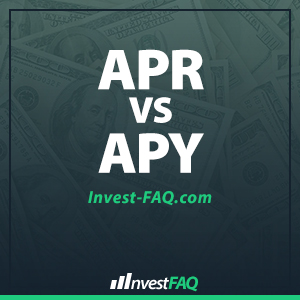 This article discusses the two main percentage rates that you may want to understand when you are trying to choose a savings account or understand the amount you are paying on a loan: annual percentage rate (APR) and annual percentage yield (APY).
This article discusses the two main percentage rates that you may want to understand when you are trying to choose a savings account or understand the amount you are paying on a loan: annual percentage rate (APR) and annual percentage yield (APY).
Annual percentage rate (APR)
In a savings account or other account that pays you interest, the annual percentage rate is the nominal rate paid on deposits. This may also be known as just the rate. Most financial institutions compute and pay out interest many times during the year, like every month on a savings account. Because you can earn a tiny bit of interest late in the year on the money paid out as interest early in the year, to understand the actual net increase in account value, you have to use the annual percentage yield (APY), discussed below.
In a loan or other arrangement where you pay interest to some financial institution, you will also encounter annual percentage rates. Every loan has a rate associated with it, for example a 6% rate paid on a home mortgage. Federal lending laws (Truth in Lending) require lenders to compute and disclose an annual percentage rate for a loan as means to report the true cost of the loan. This just means that the lender is supposed to include all fees and other charges with the note rate to report a single number, the APR. This sounds great, but it doesn’t actually work so well in practice because there do not appear to be clear guidelines for lenders on what fees must be included and which can be omitted. Some fees that are usually included are points, a loan processing fee, private mortgage insurance, etc. Fees that are usually omitted include title insurance, etc. So the APR of a loan is a useful piece of data but not the only thing you should consider when shopping for a loan.
Annual percentage yield (APY)
The annual percentage yield of an account that pays interest is the actual percentage increase in the value of an account after a 1-year period when the interest is compounded at some regular interval. This is sometimes called the effective annual rate. You can use APY to compare compound interest rates. The formula is:
APY = (1 + r / n ) ^ n - 1
Where:
- ‘r’ is the interest rate (e.g., r=.05 for a 5% rate)
- ‘n’ is the number of times that the interest is compounded over the course of a year (e.g., n=12 for monthly compounding).
The symbol ‘^’ means exponentiation; e.g., 2 ^ 3 = 8. For example, if an account pays 5% compounded monthly, then the annual percentage yield will be just a bit greater than 5%:
APY = (1 + .05 / 12 ) ^ 12 - 1
= 1.0042 ^ 12 - 1
= 1.0512 - 1
= .0512 (or 5.12%)
If interest is compounded just once during the year (i.e., annually), then the APY is the same as the APR. If interest is compounded continuously, the formula is
APY = e ^ n - 1
where ‘e’ is Euler’s constant (approximately 2.7183).
Article Credits:
Last-Revised: 15 Feb 2003
Contributed-By: Chris Lott
